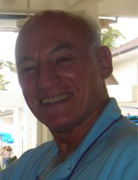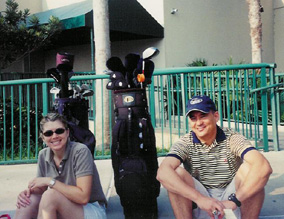|
GOLFING OKINAWA
By Bob Enzel
Situated
between the East China Sea and the Pacific Ocean near the end of the
Ryukyu Island chain is the infamous island of Okinawa. Okinawa,
of course, was the site of Japanís last naval stand against the Allies
in WWII. Many, many lives were lost on
both sides and itís
certainly worth a visit for those who like to view former battle sites
to enlarge their sense of history. These days, Okinawa
is also considered a great location for scuba diving, but
certainly does not appear as a top golf vacation site.
Yet
the Island sports over half a dozen golf courses, which is quite a
lot for this smallish island. Sightseeing and weather conditions
during my visit allowed me only enough time to play the Banyan
Tree Golf Course situated on the Kadena Air Base. A rather neat
little course situated adjacent to the flight take off and landing
field of Air Force fighter jets.
 The
par 72 Banyan Tree offers golfers a choice of the 6,604 yard Blue
Tee; a 6,250 Red Tee or a 4,951 yard White Tee. Not knowing
the course we opted for the Red Tee yardage. Without benefit of any
significant sand-holes and only a few water-holes, the narrow fairways
and rough provided enough of a challenge. One might consider
the rough as being a sharp-edged-rough...hard on legs in short pants. The
par 72 Banyan Tree offers golfers a choice of the 6,604 yard Blue
Tee; a 6,250 Red Tee or a 4,951 yard White Tee. Not knowing
the course we opted for the Red Tee yardage. Without benefit of any
significant sand-holes and only a few water-holes, the narrow fairways
and rough provided enough of a challenge. One might consider
the rough as being a sharp-edged-rough...hard on legs in short pants.
During
our round somewhere between the 11th and 18th hole we were entertained
by four waves of four F-15's taking off for
The
course fee was nominal--very inexpensive for military and reasonable
for non-military. There is a very nice pro shop where rental
golf clubs are offered at a choice of $7.00 for an everyday set of
thirteen or $15.00 for a high-end set of Calloway/Mizuno quality clubs.
Golf carts and pull carts are available as is a driving range.
A nice little snack bar-restaurant with a view of the air field
round out the facilities. The course opened in 1960 under the
name Kadena Golf Course on non-farmed land and is now able to employ
over 100 local Okinawans who maintain the facilities.
Okinawa
is not Hawaii. The island was officially returned to the Okinawans
in 1972. At which time the Okinawan government opted to return
to their heritage by using the yen as currency, driving on--what we
call--the wrong side of the road, and having most of their signage
in their native language. There did not seem to be many--if
any--foreign tourists looking and poking about. Of course, natives
from the main island of Japan were in abundance checking out the battle
sites, memorials, temples and the relatively new aquarium and park
complex. All very interesting I might add. There is now
a movement afoot to construct European type gambling casinos to attract
tourism to the island. In fact, a delegation visited Austria
to view and consider this type of attraction.
More
information about the Banyan Tree facilities and a map of the course
layout may be found on www.18services.com/golf.
|